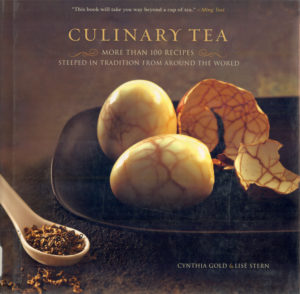
Culinary Tea More Than 150 Recipes Steeped in Tea from Around the World. Cynthia Gold and Lisë Stern. Published by Running Press, Philadelphia and London, 2010.
As you leaf through the first few pages and begin to look at recipes in chapters for “Starters” and “Entrees” in Culinary Tea More Than 150 Recipes Steeped in Tea from Around the World, a strong exotic note stands out in the authors’ collection of classic recipes. Because we know tea originated far away in distant lands and so names foreign and familiar become the landscape of tea and its culinary exploration is limitless. And when brewed perfectly from its green, black or white leaves, the exotic liquor is steamy or iced, clear-tinted and potently alive with health-giving benefits. Many of the over 150 recipes can be converted to vegetarian or vegan fare, although there are those recipes best left to the omnivore’s palate. Yet no matter your culinary orientation, you will gain an in-depth knowledge of culinary tea: specifically how the character of tea enhances the dish. Tea takes to the fat in a recipe—from dairy (or non-dairy milks and creams) and chocolate, also nicely makes up to fruits and vegetables, meat and fish, salt or spicy foods, for example, and even non-tea foods added to your tea brews make unique, personalized tea-affects. Other ways add texture with tea, like spice to cookies or spice rubs for marinating. And tea really cultures soy sauce or simple syrups, for exciting and distinctive taste treats. There are even more methods you will acquire with this book by the arbiters of taste in culinary tea.
You could go no further than “Starters” or perhaps skip all the way to the final of the eight chapters for “Tea Beverages” and acquire well over thirty new recipes for your repertoire from each section. (Actually with “Beverages”, 58 different recipes including non-alcoholic syrups, ice teas, tea creams, smoothie, lassi, etc. and cocktails will significantly advance your skills.) A vegetarian entrée comes alive with layers of flavors by adding tea, and so you create subtle or brazen character in soups, sauces, condiments, appetizers, and more. Breeze past these introductory recipes and kick up a culinary storm with confections, cookies, cakes and pastries, custards, fruits, ice creams or sorbets. These tea-infused dishes are so special because they’re conceived by a tea sommelier whose knowledge of the beverage extends to use of it as a spice, along with a companion writer who shares her enthusiasm for tea drinking and eating.
If you’re looking for a holiday treat, consider this tea cookbook and its recipes. I recognize so many favorites that have a fresh new face with tea as a flavoring or texturing agent. When brewed perfectly from its green, black or white leaves, the exotic liquor is steamy or iced, clear-tinted and potently alive with health-giving benefits. And the quality of flavor that tea infusing offers is remarkable, and you can use a scented tea for its multiple layers of flavoring. For instance I was surprised to find that a tea-infused recipe would lend such flair to …
More in Part 2!



